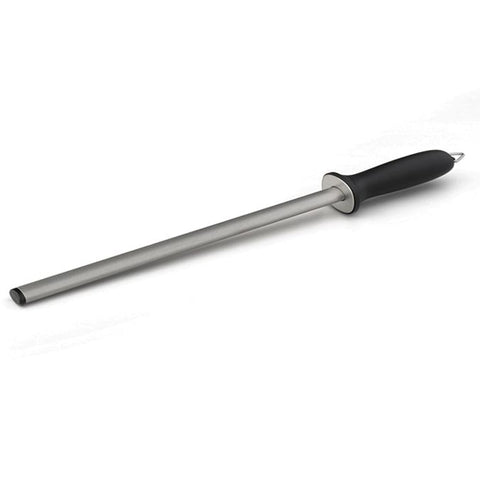What is the Difference Between a Diamond Coated Honing Steel and a Regular One?
As the name suggests a diamond coated honing steel is coated in a very fine layer of diamond dust. This coating is actually harder than the steel that your knife is made from and can therefore easily "hone" your knife's edge. By honing the edge of the blade the steel removes micro burrs that the human eye struggles to see and realines the knife edge.
Diamond coated honing steels are a must if you have invested in high carbon and Damascus cooking knives as a regular honing steel does not have the hardness to manipulate the knife's edge. High carbon and Damascus knives are typically much harder than regular stainless steel knives and this is why a regular honing or "sharpening" or steel or rod just won't cut the mustard. View more about the option of knives sharpeners here.
Be warned though a diamond coated honing steel will sharpen your knife, fast, so try to use it sparingly as each stroke of the sharpener is actually grinding off the steel of your knife and this will be magnified if you have just a regular stainless steel knife. The good side of this is that your cooking knife or any other type of knife you have and want to sharpen will be ready to slice and dice in a jiffy.
Diamond coated honing steels when new will seem to be quite rough but the grit will wear off as you bed it in. Each pass on the honing steel with your knife will make it feel smoother and smoother. After the steel is bed in the feel overall will feel uniform and not as rough as it was when new. This is normal and it will still realine and de burr your blades just with slightly less aggression.
Use of the honing steel AKA honing rod is quite simple. All you need to do is drag your knife gently along the the honing steel paying close attention to the angle that your knife is set at. Typically cooking knives are sharpened at a 20 degree angle but check with your knife maker as they can and do differ. Traditional Japanese knives are typically ground at a 15 degree angle unless they are meant for heavy duty cutting and chopping. Hunting and pocket knives are typically 22 - 30 degrees so don't guess and ask your knife maker.
As you drag the knife along the steel alternate the side of the knife that you hone so you end up running your blade along it on each side an even amount of times.
Warning!!! If you have a pretty Damascus knife or another type of highly polished knife, or, any other knife that matter. Be careful to drag the knife over the steel at the correct angle, if you get it wrong and slide the side of the blade across the honing steel it will leave scratched across your knife.
We recommend a 10 inch honing steel unless you have knives that are longer than 8 inches. The extra length of say a 12 inch honing steel just makes it harder to store without any real advantage.
Believe it or not a dull or blunt knife is more of a danger to the chef than a razor sharp knife as it will be more prone to slipping and will need to be used with more force to cut through food. When the knife slips and your fingers are cut the wound will be much worse from the force behind the knife.
We have one of these Taidea 10" - 25.5cm 600 grit diamond coated honing steels in out test kitchen that we have been using for over a year and it still works perfectly. Pick one up here to help keep your knives smart.

















































